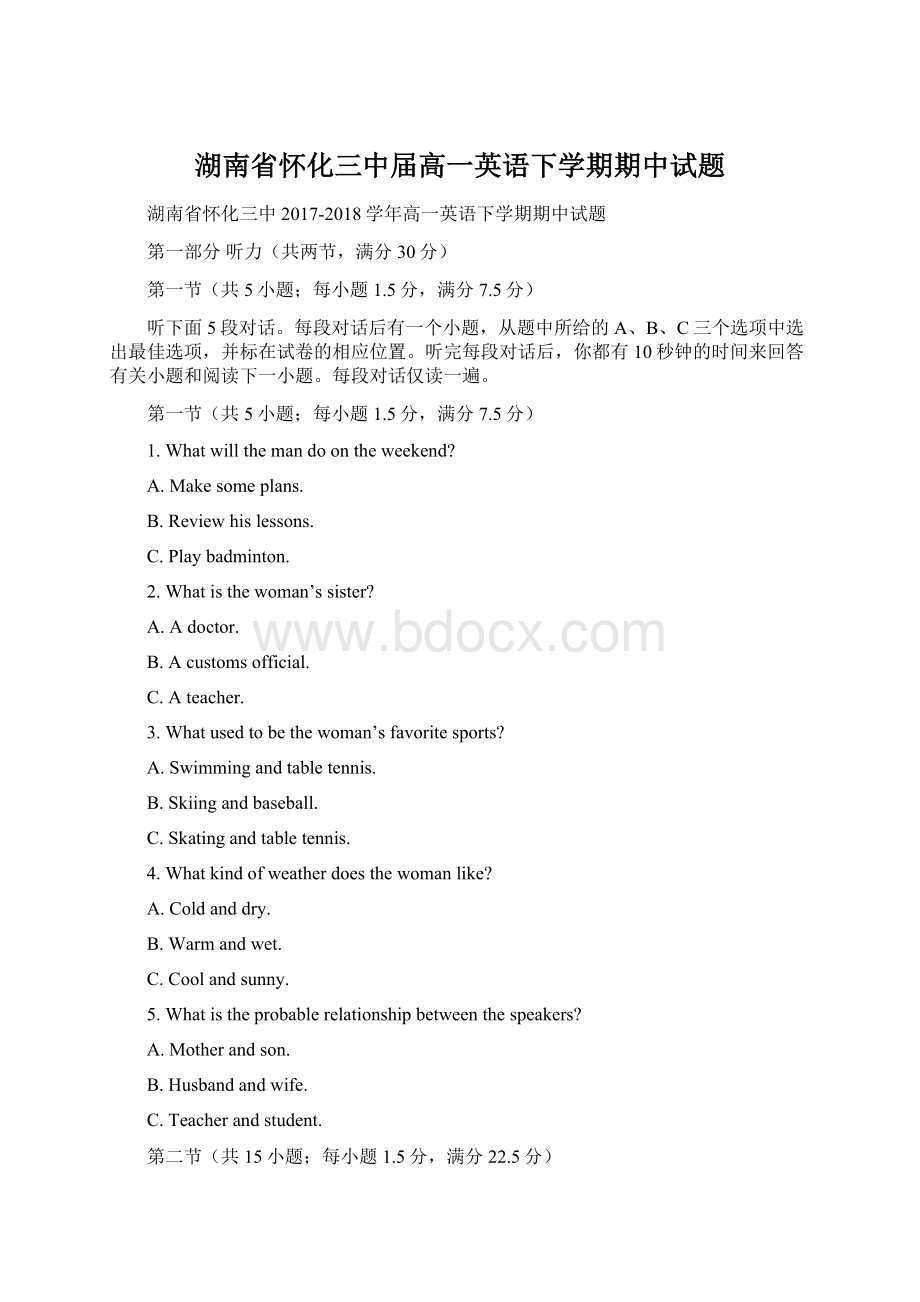湖南省怀化三中届高一英语下学期期中试题.docx
《湖南省怀化三中届高一英语下学期期中试题.docx》由会员分享,可在线阅读,更多相关《湖南省怀化三中届高一英语下学期期中试题.docx(15页珍藏版)》请在冰豆网上搜索。

湖南省怀化三中届高一英语下学期期中试题
湖南省怀化三中2017-2018学年高一英语下学期期中试题
第一部分听力(共两节,满分30分)
第一节(共5小题;每小题1.5分,满分7.5分)
听下面5段对话。
每段对话后有一个小题,从题中所给的A、B、C三个选项中选出最佳选项,并标在试卷的相应位置。
听完每段对话后,你都有10秒钟的时间来回答有关小题和阅读下一小题。
每段对话仅读一遍。
第一节(共5小题;每小题1.5分,满分7.5分)
1.Whatwillthemandoontheweekend?
A.Makesomeplans.
B.Reviewhislessons.
C.Playbadminton.
2.Whatisthewoman’ssister?
A.Adoctor.
B.Acustomsofficial.
C.Ateacher.
3.Whatusedtobethewoman’sfavoritesports?
A.Swimmingandtabletennis.
B.Skiingandbaseball.
C.Skatingandtabletennis.
4.Whatkindofweatherdoesthewomanlike?
A.Coldanddry.
B.Warmandwet.
C.Coolandsunny.
5.Whatistheprobablerelationshipbetweenthespeakers?
A.Motherandson.
B.Husbandandwife.
C.Teacherandstudent.
第二节(共15小题;每小题1.5分,满分22.5分)
听下面5段对话或独白。
每段对话或独白后有几个小题,从题中所给的A、B、C三个选项中选出最佳选项,并标在试卷的相应位置。
听每段对话或独白前,你将有时间阅读各个小题,每小题5秒钟;听完后,各小题将给出5秒钟的作答时间。
每段对话或独白读两遍。
听第6段材料,回答第6、7题。
6.Whatdoesthewomanlikedoing?
A.Goingtoconcerts.
B.Goingtothemovies.
C.Spendingtimeoutside.
7.Whenwillthemanpickthewomanup?
A.At9amonSaturday.
B.At10amonSunday.
C.At10amonSaturday.1
听第7段材料,回答第8、9题。
8.Wheredoesthewoman’sunclelive?
A.InChicago.
B.InLosAngeles.
C.InBoston.
9.WhatistheusualspeedoftheAmtrakAcelaExpress?
A.240km/h.
B.130km/h.
C.300km/h.
听第8段材料,回答第10至12题。
10.WhyarethespeakerseatingWesternfood?
A.Tocelebratetheman’spromotion.
B.Tocelebratethewoman’sbirthday.
C.Tocelebratetheirweddinganniversary.
11.Wheredidthespeakersfirstmeet?
A.Inarestaurant.
B.Inateahouse.
C.Inabar.
12.Whatdoesthemangivethewomanasagift?
A.Acandlelightdinner.
B.Fivecandies.
C.Agoldnecklace.
听第9段材料,回答第13至16题。
13.Howwastheman’soldjob?
A.Boring.
B.Interesting.
C.Tiring.
14.Whatisthemaninterestedin?
A.Cycling.
B.Gardening.
C.Designing.
15.Whydidthemandovarioussmalljobs?
A.Torealizehisdream.
B.Toearnenoughmoney.
C.Tofigureouthisdesiredjob.
16.Howlongcanthewoman’ssavingssupporther?
A.Foraboutoneyear.
B.Foraboutsixmonths.
C.Forabouttwoyears.
听第10段材料,回答第17至20题。
17.Whatcanvisitorsseeonthesecondfloor?
A.Ancientvases.
B.Ancientstatues.
C.Paintings.2
18.Whenisthemuseumopenhalfaday?
A.OnTuesdays.
B.OnSundays.
C.OnMondays.
19.Whocanenterthemuseumforfree?
A.Museummembers.
B.Seniors.
C.Students.
20.Whatshouldvisitorsdobeforeleavingthemuseum?
A.Dosomecleaning.
B.Taketheirbelongings.
C.Putawaythecollections.
第二部分阅读理解(共两节,满分40分)
第一节(共15小题;每小题2分,满分30分)
阅读下列短文,从每题所给的四个选项(A、B、C和D)中,选出最佳选项,并在答题卡上将该项涂黑。
A
ThefollowingisatruestoryaboutayoungfriendofminewholivesinSt.Louis.
Andywasbornwithadevelopmentaldisease.Thetwosidesofhisbrainwerenotjoinednormally,sothattherightsideofhisbodycouldnotexchangeinformationwiththeleft.Attheageofthree,itwasdifficultforhimtowalk,speak,andplay.Hecouldonlysayafewwords,andwalkslowlywithsomeonehelpinghim.
Heattendedacenterwherehetriedeveryimaginabletreatment,struggling,sometimesintears,togetstronger.Andyhateditwhenhisparentswouldleavehimthereinthemornings.However,theybelievedthathecouldgrowuptoliveanormalhealthylife.Theybelieveditforthemselves,andforAndy.
Itpaidoff.TodayAndyisasuccessful13-year-oldhigh-schoolstudent.Hisprogresshasbeenhuge.Hereceivesspecialhelpwithafewthings,butcanjoinhisfriendsinalltheactivitiesheloves.Andyhasovercomemanydifficultiesinmovingfromadversity(逆境)tovictory(胜利).
"Overnightsuccess"istheresultofyearsofstrongwillandcontinuedlearning.Victoryispossibleforthosewhoconsideritastheirstrongestneed.They’llfindthepathtotheirdream.However,theyshouldacceptadversitiesasordinarythingsthatwilldevelopstrength,growth,andskillstoattractthevictory.
21.WhichofthefollowingcanbeusedtodescribeAndy?
A.Energeticandpolite.
B.Modestandcreative.
C.Disabledbutstrong-minded.
D.Seriousbutwarm-hearted.
22.FromthepassageweknowthatallthefollowinghelpedAndyalotEXCEPT______.
A.treatmentatthecenter
B.hisparents’trustandhelp
C.livinginSt.Louis
D.hisstrongwill
23.Theauthormainlywantstotellusthat______.
A.Andyisoneofhisorherfriends3
B.Andyhasovercomemanydifficulties
C.parents’helpisveryimportanttotheirchildren
D.Victoryneedshardwork
B
Asamanagerinmyformercompany,Ihadsoonrealizedthatitwasimportantformetodevelopcertainskills.Oneofthesehadtodowithbodylanguage.
LetmecomparebodylanguageinIndiawiththatinNorthAmerica.
InthesouthernpartofIndia,awomanmanagerwillneverextendherhandwhenyougreether.Shejustsayshelloorgoodmorning,andneverallowsanykindofbodycontactwithaman.ButinthewesternpartofIndia,awomanmanagerwillwarmlyextendherhand.InNorthAmerica,too,awomanmanagerwillhappilyshakehands,andit’simportanttoshakefirmly.
InIndianculture,thebossisalwayscalled"Sir",andsuperiors(上级)andoldpeoplearealwayscalled"Mr."Eyecontactwiththebossisconsideredveryrude.Avoidingeyecontactwiththeoldisconsideredasignofrespect.ButinNorthAmericanculture,eyecontactisveryimportant.Avoidingeyecontactisconsideredasdoubt.NorthAmericanbossesaresoinformalthattheylovetobecalledbytheirfirstnames.However,Ihadahardtimecallingmybossbyhisfirstname.Ittookmetwomonthstogetusedtoit.IalsofounditveryfunnywhenIlearntthatcallingsomebody"Mr.[FirstName]"isconsideredrudeinNorthAmerica.
24.Theunderlinedword"extend"inthethirdparagraphprobablymeans"______".
A.reachoutB.takebackC.putupD.giveaway
25.WhichofthefollowingisconsideredpoliteinsouthernIndia?
A.Callingabossbyhisfirstname.
B.Shakinghandswithawoman.
C.Kissingawomanmanager.
D.Greetingawomanwithwordsonly.
26.Wecanlearnfromthepassagethat______.
A.theauthorislikelyfromNorthAmerica
B.peopleinwesternIndiashakehandswhengreetingeachother
C.avoidinglookingintosomeone’seyesisconsideredasdoubtinIndia
D.youwillbeconsideredpoliteifyoucallaNorthAmerican"Sir"
27.Inthepassagetheauthormainlytellsus______.
A.howtousebodylanguage
B.Howmanyimportantbodylanguages
C.thatbodylanguagechangeswithculture
D.aboutbodylanguageonlyinIndia
C
Howmanytimeshaveyoulaughedtoday?
Haveyoueverwonderedwhatmakesyoulaugh?
Inthewholeanimalworld,onlywehumanscanlaugh.Onaverage,welaughabout17timesaday.
Laughterisanaturalreactionofthebodytosomethingfunnyorpleasant.Haveyounoticedthatwhenyoulaugh,manypartsofyourbodyrespond(反应)?
Yourfaceexpressionchanges,yourbreathingchanges,andmusclesthroughoutyourbodyareaffected.
Aninterestingstorydatesbackto1962.InaschoolinTanganyika,inAfrica,agroupofschoolgirlsstartedlaughinguncontrollablyoverajoke.Thislaughterbecameepidemic(传染的),jumpingfromonepersontothenext,spreadingacrosscommunities,andlastingforsixmonths!
Sostrongwasthe"laughterepidemic"thatschoolshadtoshutdowntillitended.
Howwelaughremainsaunknown.Whateverthereasons,laughter,asthesayinggoes,"isthebestmedicine."Infact,sciencehasproventhatbeinghappyandlaughingcannotonlykeepushealthyandfitbutalsohelpdealwithseriousillnesses.
Laughingexercisesalltheimportantmuscles,andkeepsyoufit.Peoplehavestartedforminglaughterclubsthatuselaughtertotreatillnesses.Theymeetatspecificplacesatfixedtimesandlaughtogether.Laughterspreads,sothisexerciseworksbestingroups;onceonepersonstartslaughing,othersautomatically(自动地)joinin.
28.Accordingtothetext,laughteris______topeople’shealth.
A.harmfulB.uselessC.goodD.terrible
29.Peoplehaveformedlaughterclubsto______.
A.killtimeB.relaxC.meetothersD.treatillnesses
30.Thebesttitleforthepassagewouldbe______.
A.ALaughterEpidemic
B.WhatLaughterIsandWhatLaughterCanDo
C.TheRelationshipBetweenLaughterandHealth
D.HowLaughterHelpsCureDisease
31.Thepassageisprobablytakenfroma(n)______.
A.advertisementB.novelC.magazineD.storybook
D
Alarmedbyhowmanycigarettebutts(烟头)arethrownawayintheparksofAmsterdam,twoDutchdesigners,RubenvanderVleutenandBobSpikman,cameupwithanunusualplantotraincrows(乌鸦)topickupthecigarettebuttsandtradethemfortastyrewards.
“Whatwewantmostisthatthecrowsassociatefoodwithbutts,”vanderVleutensaid.Toachievethis,theyplantofollowafour-stepprocess.Thefirststeppresentsthecrowwithacigarettebuttandatreatonatray(托盘)inamachinecalledCrowBox.Thishelpsthebirdassociatethebuttwiththefoodsothatitwillcomebackformore.
Inthesecondstep,theytakeawaythefoodandonlydropitwhenthecrowarrivesattheCrowBox,whichhelpsitlearnthatthemachinereallyworks.Duringthethirdstep,thecrowlearnsthattheCrowBoxrespondstocertainactions.Theytakeawaythefoodcompletely,leavingonlythecigarettebuttonthetray.Thecrow,usedtothefoodalwaysbeingthere,willstartpecking(啄食)aroundforitandeventuallypushthebuttintothemachine’scontainer,causingthefoodtodrop.
Inthefourthstep,whenthecrowiscomfortablewiththethirdstep,apersonputssomebuttsaroundthemachine.Nowthecrowhastofindoutitcanpickupthose